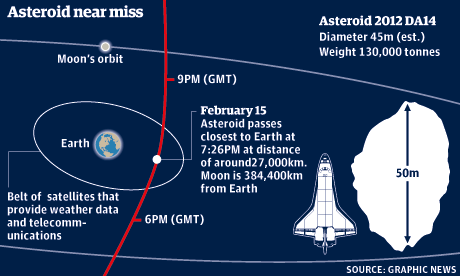UK asteroid fly-by
Measuring 45 m in diameter, weighing 130,000 tonnes and travelling 8km a second, “2012 DA14” will pass within the moon’s orbit of Earth as the space-rock intersects Earth’s orbit. The event marks the closest known passing of a large asteroid; however scientists have reassured the public that the object will not strike the Earth’s surface.

(C) Photograph: Graphic
The 150 ft object will pass approximately 8,000 km closer to Earth than geostationary orbiting satellites (those that provide communication and weather radar). The trajectory of the Near Earth-Object (NEO) will be adjusted due to the enormous gravitational pull of the Earth.
The close approach will perturb its orbit so that actually instead of having an orbital period of one year, it’ll lose a couple of months (Donald Yeomans of NASA’s Jet Propulsion Laboratory)
The NEO’s closest point to the earth’s surface will be in Sumatra, Indonesia where it will be at an altitude of just 27,520 km. The asteroid should be visible in the UK from 7.24pm GMT, weather permitting of course. The rock is expected to climb in the north-eastern sky and should take two hours from 8pm GMT to pass between the constellations of Leo and the Plough. It is not expected to be bright enough to be seen by the naked eye, but any form of magnification from binoculars or telescopes should suffice.
The asteroid will be a faint dot of light moving at a steady rate between the stars. It’ll be thousands of times fainter than Jupiter and 250 times fainter than the stars of the Plough. The trick will be to find the area in advance and wait for it to come through. You can use the star maps to find exactly the right part of the sky. If you hold your binoculars steady you will see this tiny point of light crawling across your field of view in about seven or eight minutes (Robin Scagell, vice-president of the Society for Popular Astronomy)

(C) blog.barentsen.be

Trajectory across the north-eastern sky (C) University of Hertfordshire
If the weather is unfavourable to view the NEO then NASA is set to provide a half-an-hour broadcast from 7pm GMT on NASA Television and on its website by using observatories in Australia. Additionally, independent website Slooh.com has access to webcams across the Canary Islands and will begin a webcast at 2am GMT.
The pass could potentially be a once in-a-lifetime opportunity to spectate on a extra-terrestrial phenomenon and should not be missed.
GeoJames

Leave a comment